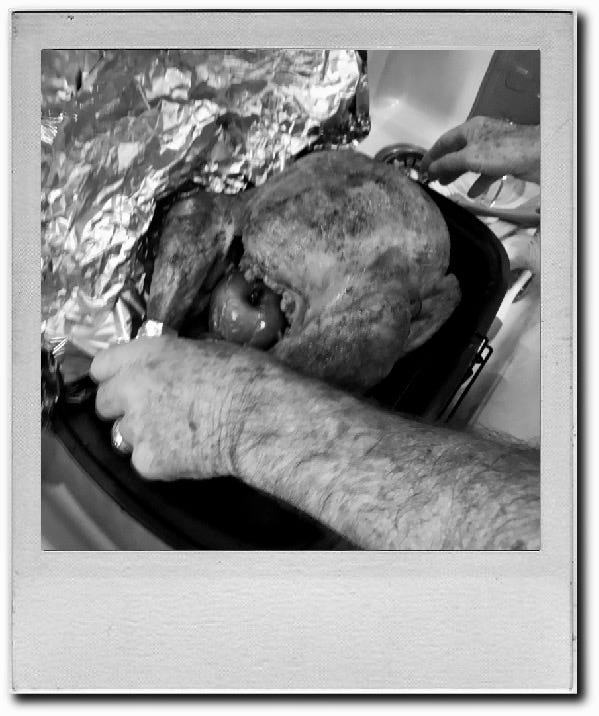We Need to Talk About Collective Grieving
American culture shies away from death, grief and mourning — something we can’t continue doing after an ongoing pandemic.
Story by Joslin Keim
A pair of tough, wrinkled and freckled hands carefully lifts a whole turkey out of a baking dish. This is the last photo I have of my grandpa. I took the photo on Thanksgiving of 2019, a month before his unexpected passing.

Some days I skip past the photo in my camera roll. Other days I stare at it, trying to memorize the hair on his arms and the smell of his cooking. I worry I’ll forget how he looked and sounded or the hats and shirts he wore. Most of them have been donated already, though one shirt hangs in my closet. I miss the old, worn-in leather of the jacket he always wore when he came to visit.
A May 2020 New York Times headline showed a thousand names, ages and one-line summaries of some of the 100,000 people in the U.S. who have died from COVID-19 up to that point. It was — and is — painful to read through each name. They were all people and now they’re all gone.
In the past, I’ve found we don’t talk about death in American culture, especially white American culture. We skirt around it instead.
The COVID-19 pandemic will bring about prolonged periods of grief that feature characteristics of trauma according to a paper written for the American Psychological Association by psychologists Cyrille Kossigan Kokou-Kpolou, Manuel Fernández-Alcántara and Jude Mary Cénat in August 2020.
They said that grief overload, increased feelings of guilt, distress and inability to say farewell at funerals are likely to contribute to trauma within the grieving process, both collectively and individually.
The above responses to grief contribute to prolonged grief disorder, a psychiatric category that the authors say will see a sharp increase in the aftermath of the pandemic.
The ongoing pandemic and now the looming threat of COVID-19 variants has shifted to the inevitable: We need to talk about death.
We need to truly let ourselves fall into our grief, no matter how deep or shallow the fall.
Caitlin Koch helps families do this through her work as executive director at Our TreeHouse in Bellingham, WA. Our TreeHouse in Bellingham aims to create a safe space where people, specifically families, can feel their grief and heal together.
Koch said the groups at Our TreeHouse use a peer-support model, grounded in a belief that it’s vital for grieving people to connect with others who have experienced similar situations and feelings.
“There’s no timeline to grief,” Koch said. “In the same way that people experience grief differently, what that looks like in terms of how long that lasts, how intense it is, over a certain period of time differs for each person.”
Koch talked about the way COVID-19 brought on a different kind of trauma to those who lost family members during the pandemic — situations like not being able to be with a person at their time of death or not being able to say goodbye.
“It’s a lot more complicated than it has been in the past,” Koch said.
Personally, the pandemic left me with so many questions about my grandpa: How would he have reacted to mask mandates and toilet paper panic-buying? Would he have watched the nationwide Black Lives Matter protests or shared his opinions on the Capitol Hill Autonomous Zone? Would he have still driven his motorcycle, or would he take the car to feel a little safer when commuting? Where would he have traveled to first after getting his COVID-19 vaccine?
Depending on the month, COVID-19 deaths in people 75 and older ranged from 1–55 people per 100,000, according to the CDC’s data tracking. As more people have gotten vaccinated in the last few months, that number has fallen.
This is good news, though I worry that this statistic could stand in place of processing the deaths we saw happen. We may be swerving around emotions as a way of avoiding them.
A downward trend on a graph can’t process our collective grief. Each of us has to choose to face it.
As of July 2021, over 600,000 Americans have died from COVID-19 according to the CDC. Learning to talk about death doesn’t make that number any easier to digest, but it makes the choice to look grief in the eyes a little less intimidating.
“You’ll never forget the person who’s died, you’ll never get over your grief,” Koch said. “You won’t stop grieving but it will change over time.”
I think we should take time to ask ourselves these questions: How do we start processing a death toll as high as 600,000 people? As our country opens up, how do we grapple with the significance of this many deaths?
Is there one specific, concrete answer to these questions? No. Everyone’s grief will be similar yet different. That’s exactly why we need to face it.
